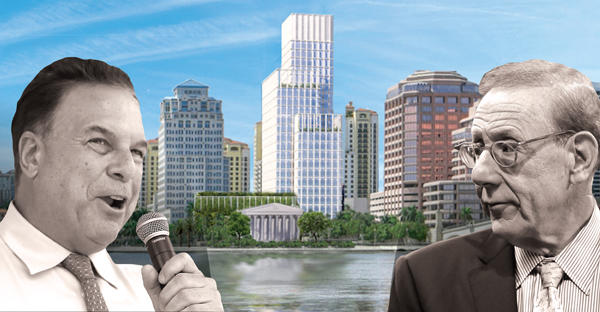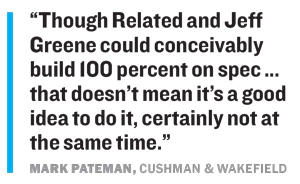Trending
The race for space in West Palm Beach

Real estate executive and Miami Dolphins owner Stephen Ross scored the most recent victory in the battle of billionaires looking to build high-rise office projects in downtown West Palm Beach. Ross was on an apparent collision course with Jeff Greene, real estate investor and former candidate for governor of Florida, but it appears that New York-based Related Companies, led by Ross, has won out — for now.
In reaction to the August news that part of the downtown would be upzoned, thereby allowing Related to proceed with a 25-story office project called One Flagler, Greene shelved his One West Palm project, citing an “uncertain zoning climate.” The city-approved project was a mix of office space, hotel rooms and apartments in two 30-story buildings, designed by Miami-based Arquitectonica.
The cancellation of Greene’s project seems to have exposed limits to commercial development in the central business district of West Palm Beach, despite local efforts to recruit out-of-town employers.
In a Sept. 8 interview, Greene said that when he won city approval for his mixed-use One West Palm development about two years ago, downtown West Palm Beach needed more hotel rooms and office space.
 But now “we’ve got too many hotel rooms, and office space is very speculative,” Greene said, citing his attempt to recruit co-working facility operator WeWork for office space at One West Palm. “They were looking at four different choices here. There’s plenty of office space.”
But now “we’ve got too many hotel rooms, and office space is very speculative,” Greene said, citing his attempt to recruit co-working facility operator WeWork for office space at One West Palm. “They were looking at four different choices here. There’s plenty of office space.”
Greene told TRD he decided not to build One West Palm as planned but won’t sell the development site, which he bought four years ago for $15 million. He may instead pursue a purely residential version of One West Palm.
The billionaire believes the One West Palm site could be a successful location for two 30-story luxury apartment buildings. But as an apartment development site, “it’s zoned for 15 stories, so we would have to see if we could get the same kind of [zoning] variance they gave to Related,” Greene said.
Greene had loudly opposed the zoning change, a measure that Related Companies (a separate entity from Related Group of Florida, headed by Jorge Pérez) had proposed. The change created a new downtown district that removed the old five-story limit on building height along an eastern stretch of Okeechobee Boulevard ending at Flagler Drive, a picturesque road that winds along the Intracoastal Waterway. The City Commission unanimously approved the creation of the Okeechobee Business District in August. Related’s Ross declined to speak to TRD for this story.
While Greene groused at the board’s decision, he too has been the beneficiary of upzoning. He bought the One West Palm development site at 550 Quadrille Boulevard in 2014, and in 2015, his property was included in a downtown corridor that the city designated as the Quadrille Business District, allowing office developments up to 25 stories and office-and-hotel developments up to 30 stories.
But not all upzonings are created equal, in Greene’s view. While the entire Quadrille Business District is well west of the waterfront in West Palm Beach, Related Companies’ One Flagler site is “right up against the water” on the eastern end of the Okeechobee Business District, he said. “What if I had started building it [One West Palm], and then I found out that suddenly I’m competing with a building right on the water? … The city has proven to be very unpredictable and unreliable in its zoning.”
Related’s One Flagler was designed with 285,000 square feet of office space — 42 percent more than the office component of Greene’s One West Palm. If both were built, One West Palm and One Flagler would put a total of 485,000 square feet of new office space downtown, and that’s in addition to Related’s 360 Rosemary, an 18-story office building with another 297,000 square feet of space on Rosemary Avenue, where site preparation work started in September.
 Altogether, that would add up to a lot of space in a city where large office tenants are scarce.
Altogether, that would add up to a lot of space in a city where large office tenants are scarce.
“As far as attracting new tenants to the West Palm market, we don’t get very large office space users for downtown West Palm Beach. The average-size user is about 3,500 square feet,” said Neil Merin, chairman of NAI/Merin Hunter Codman, a commercial real estate services firm with offices in West Palm Beach and Boca Raton.
“If you look at the historic [new office] absorption pace in West Palm Beach, it doesn’t support a half million square feet of space all at once,” said Mark Pateman, a managing principal at commercial brokerage Cushman & Wakefield. “Though Related and Jeff Greene could conceivably build 100 percent on spec … that doesn’t mean it’s a good idea to do it, certainly not at the same time.”
Asked if city commissioners might upzone other areas near the Okeechobee Business District, Merin replied, “The spot zoning that occurred for the Okeechobee Business District can occur anywhere in the city with appropriate lobbying.”
Patty Nooney, who oversees CBRE’s local sales operations in Palm Beach, said signs of life in the Okeechobee Business District include the city’s plan to find a developer for its so-called Tent Site, 2.37 acres at the corner of Okeechobee Boulevard and South Dixie Highway. Class A office rents are also inching up downtown, averaging $55.98 per square foot in Q2, up from $51.27 in the first quarter of the year, according to a report from JLL.
But Pateman said the new Okeechobee Business District may not have a big impact on West Palm Beach right away. Instead, he said, the creation of the district shows the city is “cleaning up its zoning and thinking about long-term growth, perhaps next cycle, or two cycles away.”
Economic development officials hope to create a bigger inventory of Class A office space for companies that want to relocate from states with high tax rates made even steeper after the Tax Cuts and Jobs Act was passed last year.
“People are definitely interested. The tax tail is wagging the dog,” said Pateman. “It’s happening. It’s just not happening in 50,000- to 100,000-square-foot increments.”
There’s also a particular style of office that tenants are looking for in Palm Beach County, according to Greene, and it’s not the kind of inventory available in West Palm. Large-scale office tenants tend to prefer low-rise suburban space, he said.
“They’re really not looking for a high-rise. They want to go to more of a campus. That’s why they go to Boca, Palm Beach Gardens, Jupiter,” he said. “I don’t see West Palm Beach ever being that.”




